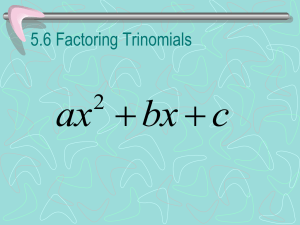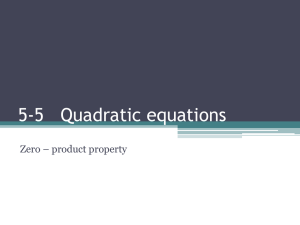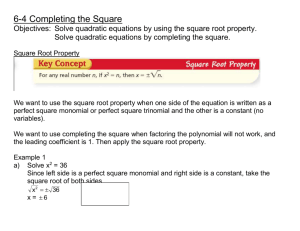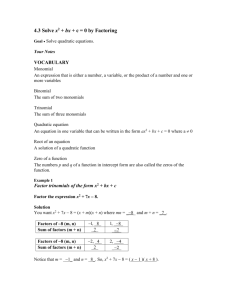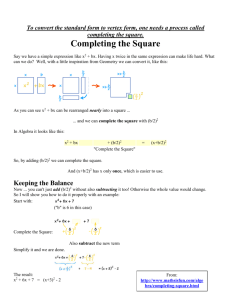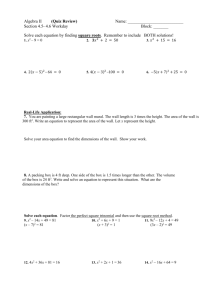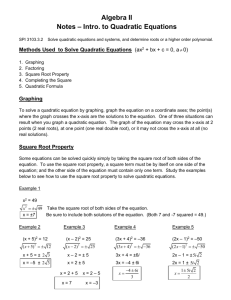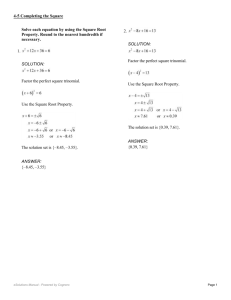Section 11.1a
advertisement
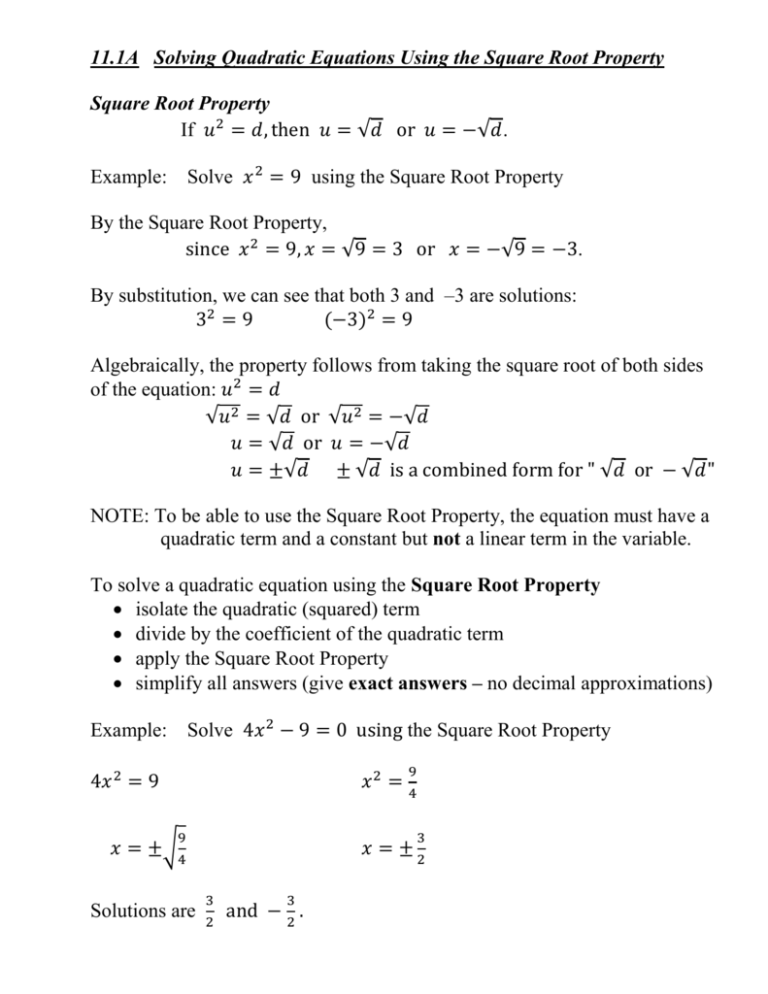
11.1A Solving Quadratic Equations Using the Square Root Property Square Root Property If 𝑢2 = 𝑑, then 𝑢 = √𝑑 or 𝑢 = −√𝑑. Solve 𝑥 2 = 9 using the Square Root Property Example: By the Square Root Property, since 𝑥 2 = 9, 𝑥 = √9 = 3 or 𝑥 = −√9 = −3. By substitution, we can see that both 3 and –3 are solutions: 32 = 9 (−3)2 = 9 Algebraically, the property follows from taking the square root of both sides of the equation: 𝑢2 = 𝑑 √𝑢2 = √𝑑 or √𝑢2 = −√𝑑 𝑢 = √𝑑 or 𝑢 = −√𝑑 𝑢 = ±√𝑑 ± √𝑑 is a combined form for " √𝑑 or − √𝑑" NOTE: To be able to use the Square Root Property, the equation must have a quadratic term and a constant but not a linear term in the variable. To solve a quadratic equation using the Square Root Property isolate the quadratic (squared) term divide by the coefficient of the quadratic term apply the Square Root Property simplify all answers (give exact answers – no decimal approximations) Solve 4𝑥 2 − 9 = 0 using the Square Root Property Example: 4𝑥 2 = 9 𝑥 = ±√ 𝑥2 = 9 4 𝑥=± 4 Solutions are 9 3 2 3 and − . 2 3 2 Example: Solve 2𝑥 2 + 4 = 4 using the Square Root Property 2𝑥 2 = 0 𝑥2 = 0 𝑥 = √0 𝑥=0 Solution is 0. Note: zero has only one square root, zero. -------------------------------------------------------------------------------Example: Solve 𝑥 2 + 6 = 1 using the Square Root Property 𝑥 2 = −5 𝑥 = ±√−5 𝑥 = ±𝑖√5 Solutions are 𝑖√5 and − 𝑖√5 . -------------------------------------------------------------------------------Example: Solve (𝑥 + 2)2 = 9 using the Square Root Property (𝑥 + 2)2 is the quadratic term. 𝑥 + 2 = ±√9 𝑥 + 2 = ±3 𝑥 = −2 ± 3 𝑥 = −2 + 3 = 1 𝑥 = −2 − 3 = −5 Solutions are 1 and –5. -------------------------------------------------------------------------------Example: Solve (𝑥 + 3)2 − 3 = 4 using the Square Root Property (𝑥 + 3)2 is the quadratic term. (𝑥 + 3)2 = 7 𝑥 + 3 = ±√7 𝑥 = −3 ± √7 Solutions are −3 + √7 and − 3 − √7 . Example: Solve 𝑥 2 − 4𝑥 + 4 = 6 using the Square Root Property This equation has a quadratic and a linear term in x. In this form, it cannot be solved using the Square Root Property. But, 𝑥 2 − 4𝑥 + 4 is a perfect − square trinomial and can be written as (𝑥 − 2)2 The original equation can now be written as (𝑥 − 2)2 = 6 and the Square Root Property can be used. 𝑥 − 2 = ±√6 𝑥 = 2 ± √6 Solutions are 2 + √6 and 2 − √6 -------------------------------------------------------------------------------Example: Solve 3𝑥 2 − 16 = 0 using the Square Root Property 3𝑥 2 = 16 𝑥 = ±√ 𝑥=± 𝑥=± 𝑥2 = 16 16 3 𝑥=± 3 4 𝑥=± √3 √16 √3 4∙√3 √3∙√3 4√3 3 4√3 4√3 Solutions are and − 3 3 -------------------------------------------------------------------------------Solving Quadratic Equations by Completing the Square Forming Perfect-square Trinomials A perfect–square trinomial with a leading coefficient of 1 is the square of a binomial, 𝑥 + 𝑏. (𝑥 + 𝑏)2 = 𝑥 2 + 2𝑏𝑥 + 𝑏 2 To form a perfect–square trinomial, given the quadratic and linear terms 𝑥 2 + 2𝑏𝑥 , do the following: 1. Find ½ of the coefficient of the linear term, 2b, OR divide the coefficient of the linear term by two. The result is the second term of the binomial being squared, b. 1 2𝑏 ∙ 2𝑏 = 𝑏 =𝑏 2 2 2. Square the result from 1. This is b2, the third term of the trinomial. 3. Add b2 to the other two terms to form the perfect–square trinomial. x2 + 2bx + b2 Once you have the perfect–square trinomial, it will be factored and written as (𝑥 + 𝑏)2 . Example: 𝑥 2 + 6𝑥 2𝑏 = 6 2𝑏 2 6 =2 𝑏 2 = 32 = 9 𝑏=3 Perfect-square trinomial is 𝑥 2 + 6𝑥 + 9 Factored form of the trinomial is (𝑥 + 3)2 -------------------------------------------------------------------------------Example: 𝑥 2 − 3𝑥 2𝑏 = −3 2𝑏 2 = −3 2 𝑏=− Perfect-square trinomial is 𝑥 2 − 3𝑥 + 3 2 3 2 9 2 4 𝑏 2 = (− ) = 9 4 3 2 Factored form of the trinomial is (𝑥 − ) 2 Note: b is negative. Perfect–Square Trinomials and Completing the Square Now that we are able to form a perfect–square trinomial, we are ready to solve quadratic equations by completing the square. Solve x2 + 6x – 1 = 0 NOTE: This equation cannot be solved by factoring. 1. Add 1 to both sides of the equation. This leaves only the quadratic and linear terms on the left side of the equation. x2 + 6x – 1 + 1 = 0 + 1 x2 + 6x = 1 2. Find the third term for the perfect–square trinomial (see Example). Add this to both sides of the equation. x2 + 6x + 9 = 1 + 9 3. Factor the perfect–square trinomial as the square of a binomial. Simplify the expression on the right side. (𝑥 + 3)2 = 10 4. Apply the Square Root Property to solve the equation. 𝑥 + 3 = ±√10 𝑥 = −3 ± √10 Solutions are −3 + √10 and − 3 − √10 --------------------------------------------------------------------------------------------Leading Coefficient of the Quadratic Term is Not 1 Start by dividing both sides of the equation by the leading coefficient and then solve as before. Solve 2x2 + 12x – 6 = 0 1. 2. 2𝑥 2 +12𝑥−6 2 = 0 2 𝑥 2 + 6𝑥 − 3 = 0 NOTE: This equation cannot be solved by factoring. 3. 𝑥 2 + 6𝑥 = 3 4. 𝑥 2 + 6𝑥 + 9 = 3 + 9 5. (𝑥 + 3)2 = 12 𝑥 + 3 = ±√12 √12 = √4 ∙ 3 = √4 ∙ √3 = 2√3 𝑥 + 3 = ±2√3 𝑥 = −3 ± 2√3 Solutions are −3 + 2√3 and − 3 − 2√3
